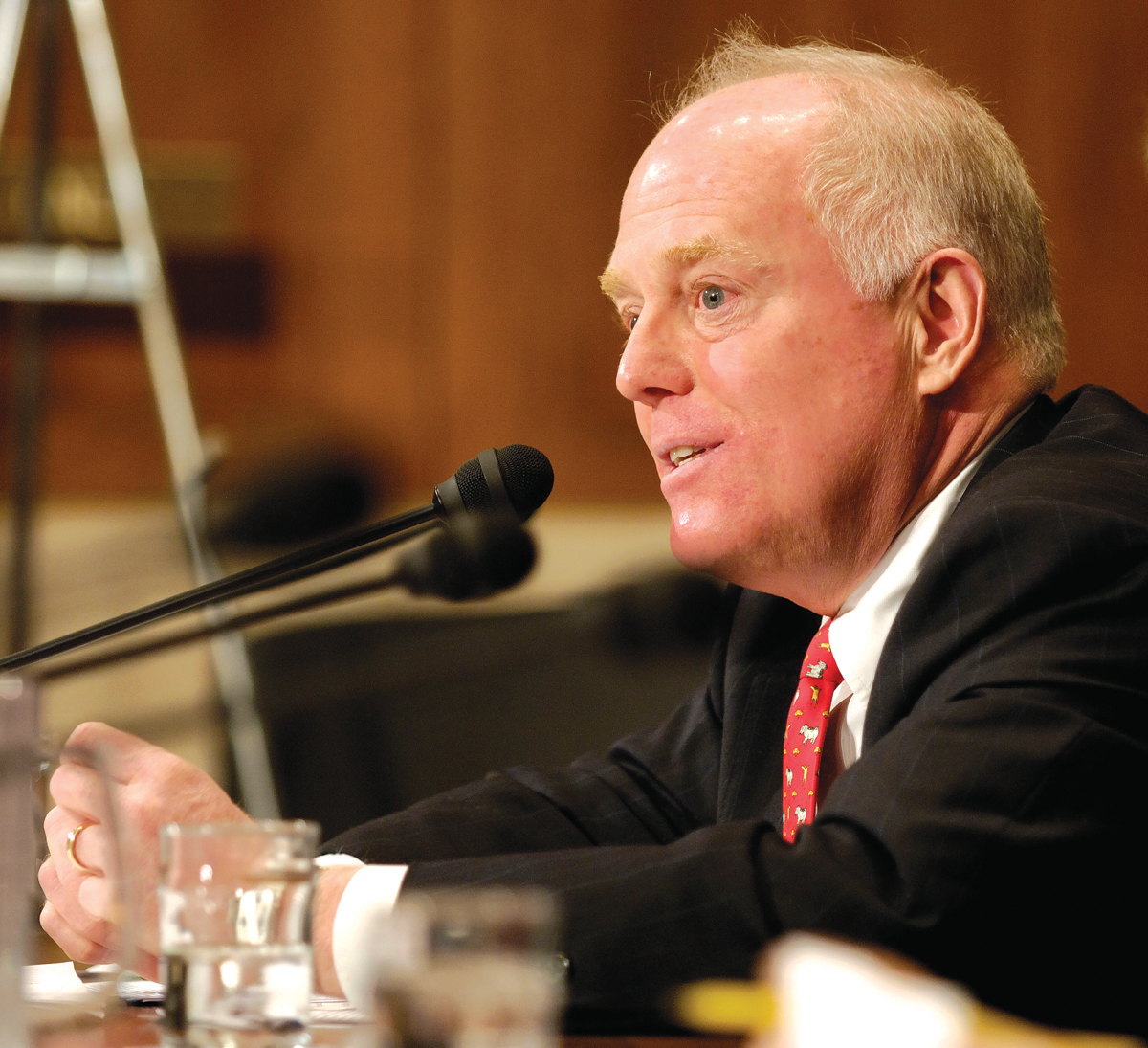By Karen Di Piazza

Pete Bunce, president and CEO, General Aviation Manufacturers Association, said VLJs won’t clog the air traffic system and aren’t a good reason to employ user fees.
Since the Bush administration’s release of its FY2007 budget in early January, general aviation trade groups have been poised for battle. The budget left the door open for user fees, and GA trade organizations have banned together and are saying “no” to a user-fee idea endorsed by the Federal Aviation Administration and proposed by the airlines’ lobbying group, Washington, D.C.-based Air Transport Association. Part of the ATA’s proposal is to jettison fuel taxes that GA currently pays into the Airport and Airway Trust Fund, which expires Sept. 30, 2007. The ATA’s proposal calls only for “business aircraft” to pay user fees and federal excise tax on fuel for piston-powered GA aircraft.
Many in the industry saw the ATA’s move as a way to drive a wedge between the GA industry overall—separate business aircraft from piston planes, thus get support from GA trade groups that represent the piston-powered groups. However, GA trade groups such as the Aircraft Owners and Pilots Association and the Experimental Aircraft Association are having none of that. Both trade groups are opposed to a user-fee system. Basically, the AOPA and EAA came out and said, “We’re not that stupid; we know we’d be next.” In fact, there isn’t one GA organization that supports the idea of a user-fee system. There is widespread opposition to the FY07 budget, as budget cuts will impede GA growth and delay certification processes.
Bush’s proposed budget
The Bush administration’s FY07 budget calls for $13.75 billion for the FAA, down from the $14.31 billion for this fiscal year, which is part of the “wham” on GA. The FY07 budget may not come out and say, “We’re proposing user fees,” says GA trade groups, but the budget released by the White House proposes to “remove the protection against aviation user fees,” included in the FY06 Transportation Appropriations bill signed into law last fall.
The FY07 budget of $13.7 billion is a combination of funds that provide the revenue source for the Aviation Trust Fund and general fund. Of those funds, $8.366 billion will provide the FAA’s operational needs, to include hiring FAA safety inspectors and replacing retired air traffic controllers, and pay roughly 1,136 new air traffic controllers, plus nearly 194 new inspectors and additional employees.
Within the proposed budget, $2.75 billion is allocated for the Airport Improvement Program grants. The airport construction grant request for 2007, which Congress approved for FY06, is roughly $800 million short of that. Transportation Secretary Norman Mineta, during a briefing discussing the Department of Transportation’s FY07 budget, said the budget was “sufficient to address construction needs for all currently planned runways,” and to include “meeting goals for improving runway safety.”
In 2005, when the Bush plan called for a $500 million cut in AIP funds, from $3.5 billion enacted by Congress in FY05, Congress didn’t see eye to eye on the proposed cut, and said no to the White House’s plan and made sure those funds were there.
During the briefing discussing the DOT’s FY07 budget on March 7, Mineta said the Bush administration’s position is that “a new funding structure is needed,” and that the current system of excise taxes, which are based on airline ticket prices, “would need to be restructured.” He said that the DOT would release the new proposal sometime this spring, but so far no proposal has been seen. Mineta also told a House subcommittee that current funding mechanisms for making transportation investments “are outdated,” and “gasoline taxes and airline ticket taxes aren’t enough to support 21st century transportation needs.” He said that the growing aviation system must have a more stable and “predictable revenue stream.” He explained that would create a more direct relationship between revenues that are collected and the services that are provided.
During the hearings, Todd Tiahrt (R-Kan.) asked Mineta if any user fees were proposed. Mineta replied, “No, there are no proposals for general aviation user fees in an FAA funding plan being reviewed by the Office of Management and Budget. I told the AOPA that.” As no user fees threatened the AOPA, the GA trade groups knew that meant protection against a user-fee plan was only for piston aircraft.
The AOPA represents about 400,000 owners and pilots, with its core member being a pilot who flies a four-place, single piston-powered airplane. So, clearly when the GA industry realized that Mineta was promising user-fee protection to only the piston crowd, they became alarmed that the Bush administration defined “GA” as piston airplanes, not the rest of GA aircraft, such as “turbine or turboprop-powered GA business aircraft.”
It’s the administration’s contention that most turbine and turboprop planes are mostly operated under FAR Part 91 for corporations’ in-house flight departments, FAR Part 135 charter operations and FAR Part 91K fractional programs, etc.
Mineta said the Bush administration would present a reauthorization plan that would include “a solid forward-looking financing proposal” for the ATF, which also expires Sept. 30, 2007. Currently, the majority of the FAA’s budget is financed from the ATF, in the form of revenue from aviation excise taxes on commercial airline tickets, cargo and GA fuel.
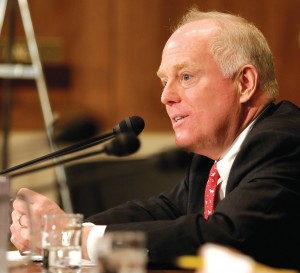
James K. Coyne, president, National Air Transportation Association, finds it odd that the Federal Aviation Administration has waited so long to submit its funding proposal, whether it supports user fees or not.
National Air Transportation Association President James K. Coyne says GA operators pay into the ATF through a fuel tax, which taxes each gallon of fuel purchased.
“Aviation jet fuel is taxed at 21.9 cents per gallon, and aviation gasoline is taxed at 19.4 cents per gallon,” he said. “The fuel tax guarantees a consistent and efficient stream of funding into the ATF; it’s a ‘direct pay-at-the-pump.’ Money is transferred from the fuel tax to the government; there’s no unwieldy bureaucracy needed for collection.”
Currently, GA is contributing 4.3 percent of fuel taxes to the ATF, and the airlines contribute 7.5 percent of airline ticket taxes to the ATF.
High stakes

Eric Byer, vice president of government and industry affairs, National Air Transportation Association, has faith that the Office of Management and Budget will scrutinize proposals before recommending any user fees.
The ATA is proposing that an estimated $2 billion annually be shifted to business aviation in contributions to the ATF, casting aside current fuel taxes paid by GA and ticket taxes paid by the airlines, rather using a one-for-all user-fee system. But that’s not all: the ATA wants to have user fee oversight control—decision-making powers on how and how much each party pays—as they believe they use the system more and should have say over the system. GA trade groups oppose that idea, too. GA groups want Congress to continue to oversee any and all monies allocated to the FAA.
So far, swords have been drawn to cut down proposed user fees. Literally every GA trade group—whether representing Fortune companies’ in-house flight departments, FAR Part 135 charter operators’ businesses, fractional providers or groups representing private pilots and recreational flying clubs—are united to fight against the ATA’s proposed plan. How and how much business aviation should pay to maintain the nation’s ATC system is at stake.
As Southwest Airlines Chair Herb Kelleher said during a luncheon keynote in late March, “The ATA for the first time had come to unanimous agreement on a new formula for funding the system.” Also for the first time, airlines have united and joined behind the ATA. Business GA trade groups believe that the ATA is a real threat because they’ve gained political alliances.
In the past, the ATA was unsuccessful in its attempts to unite most airlines in protesting various issues. This is the first time 19 airlines have joined in the same cause—pushing for user fees. With backing from major airlines, the ATA has gained substantial lobbying power on Capitol Hill.
In late March, the FAA’s annual Forecast Conference called for a “rethinking of how the U.S. aviation system is funded,” specifically calling for a “cost-based user-fee system,” but hadn’t yet submitted any funding proposal. During a Senate aviation subcommittee meeting, Marion Blakey, FAA administrator, said she couldn’t tell the Senate “if user fees are planned for all or part of GA.” Also, she couldn’t put a dollar figure on what it would cost to modernize the FAA. Her reason for secrecy was that a funding package “is currently under review” by the administration. Coyne finds that odd.
“The big question is when,” says Coyne, a former member of Congress (R-Penn.), and special assistant to President Ronald Reagan and director of the White House Office of Private Sector Initiatives.
As NATA’s president, Coyne represents thousands of Part 135 businesses in the U.S., and is no stranger on Capitol Hill. He’s also no stranger to how the political system works, or doesn’t work.
“With the White House and Congress in political turmoil, with the focus on the coming election and maintaining control of Congress, many of us are wondering why the FAA’s funding proposal has been delayed, and if there’s a political connection,” he quipped. “Perhaps the political leaders have concluded that this is a bad time to offer such a contentious plan for turning FAA funding upside down. It would be sure to stir up everyone in aviation and raise further problems for anyone trying to get reelected. So, just possibly, they may have decided to put it on the backburner for now.”
And about those AIP cuts in the president’s budget, Coyne warns, “When the AIP funding pool drops below $3.2 billion, GA airport entitlements are eliminated.”
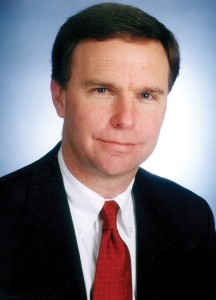
Ed Bolen, president and CEO, National Business Aviation Association, is a firm believer that the current airline fee system is appropriate, and that a user-fee system is the wrong way to go for GA.
The majority of AIP funds would go to larger airports.
“A reduction of $3.7 billion, authorized by Congress for the AIP, would severely impact GA businesses and the pilot community,” he said.
As for proposals in front of the OMB, Eric Byer, NATA’s vice president of government and industry affairs, says he has faith in the way they operate.
“I think the Office of Management and Budget will scrutinize proposals before recommending any,” he said. “As for user fees proposed by the ATA that exclude piston-powered aircraft, there are several piston planes that operate as air taxis under Part 135 operations and fractional, plus more are on the way—that hasn’t been addressed either. NATA will fight any user-fee program.”
Byer said Congress isn’t expected to take up the bill to reauthorize the FAA Airport and Airway Trust Fund until 2007.
“It could happen anytime in 2007,” Byer said. “There’s no set date. Sept. 30 of next year is a long way off.”
What the airlines want
The ATA and its consulting firm, Campbell-Hill Aviation Group, is part of a gigantic hard push for changes in how the FAA manages and pays for the nation’s ATC system. Some changes include switching from ground to satellite-based radar, which would require companies that own private aircraft to pay more into the fund, and to give “commercial airlines more power over air traffic control,” according to James May, ATA’s president and CEO.
May knows that such a proposal has caused GA trade groups to rally against this, plus the National Air Traffic Controllers Association is opposed to the ATA’s plan and opposed to a user-fee system as well. May announced to the press that the ATA is aware that they’ve picked a political fight.
“This isn’t going to happen overnight. … We live in a time where difficult choices need to be made,” he said.
May says airlines pay for more ATC services and its operations than it uses. He alleges that money paid into the current fund—from taxes on airline tickets and a fee based partly on an aircraft’s size and weight—isn’t working, or fair. The ATA wants to eliminate airline passenger ticket taxes altogether, which are estimated to generate more than $7 billion for the trust fund in 2006.
May said the ATA wants to shift about “$1.5 billion to $2 billion from the commercial airline industry to other users of the ATC system”—especially GA private businesses that May claims “don’t pay their fair share.” He believes that an imposed “user-fee-based system on departures and time in the system,” rather than the current funding of relying on airline ticket taxes, “would be fair.”
May said the FAA is burdened with literally hundreds of congressional earmarks that tell them how to spend their money. He also said “that leads to inefficiencies in the system.”
In December 2005, a study by airline expert Darryl Jenkins, commissioned by the NATCA, stated there’s “no reason to justify radical changes in the aviation-tax-and-fee system.” It explained that switching to an across-the-board user-fee-based system would require a creation of a new bureaucracy to collect the fees.
But in early March, the ATA came out with its “Smart Skies Campaign: A Blueprint for the Future.” The “blueprint” chronicles the airlines’ answers of how to fund the system laying down statements of principles.
Doug Church, NATCA’s spokesman, described the ATA’s principles as “not a good idea for the safe, reliable and redundant system we have now.”
Ed Bolen, president and CEO of the National Business Aviation Association, is a firm believer that the current airline fee system is appropriate. The costs of the air traffic system are mostly gauged by the hub-and-spoke system, which supports the commercial airline industry—not the GA industry.
“Their blueprint for the future is for them to pay less money, but exert more control,” he says. Bolen added that he didn’t see that the ATA’s blueprint was helpful.
Everyone, including GA trade groups, agrees there’s a need to improve the current air traffic system, but GA trade groups and the NATCA don’t believe the ATA has the right plan for doing so. According to the FAA, in a decade from now, when the next trust-fund reauthorization bill would expire, air traffic is forecast to increase to 60,000 flight operations a day, compared with about 45,000 today, not including new very light jets and other private GA jet traffic.
Furthering the debate over how and how much money GA should pay in user fees, the ATA claims that today, GA may contribute roughly $600 million annually to the trust fund, but argues that isn’t enough. The organization says that’s about 10 percent of the trust fund’s revenue.
According to the FAA, its 10-year forecast projects that mainline U.S. air carrier passenger counts will grow from 738.6 million in 2005 to 1.07 billion by 2017, an average growth rate of 3.2 percent. But domestic carriers are expected to drop 0.2 percent in 2006.
But the FAA claims that GA’s fleets will grow from 214,591 units in 2005 to some 252,775 by 2017, a 1.4 percent annual growth rate. The FAA is concerned about VLJs. For instance, the type certificate for the Eclipse 500 is expected by late June, and the FAA forecasts some 100 VLJs will be in service by year-end. The FAA predicts that 350 to 500 VLJs will enter the market over the next several years.
In late March, Blakey said VLJs are “a potential strain on the air traffic system,” and that “it’s a certainty that our workload continues to grow.” Blakey said that in the next few years the FAA expects GA to increase, because more VLJs are expected to emerge into the air traffic system.
The ATA claims that business GA makes up nearly a third of flights under control of the nation’s ATC system. The ATA wants all “business aircraft” to pay the same user fee, regardless of how many passengers are on board or what size of aircraft may be used. In other words, the ATA wants GA business aircraft, whether it’s a Cessna Citation X or a Boeing 757, to pay the same amount in user fees. This naturally doesn’t bode well with the GA industry.
GA trade groups ready for battle against user fees
In late March, the NBAA called upon its newly formed North Florida Business Aviation Association to oppose user-fee proposals. Why Florida? For starters, the NFBAA’s membership includes “wealthy, influential people,” says Sherrell Roberts, president of Jacksonville Executive Transportation Services Inc., and NFBAA board member, heading up the organizations community and government affairs.
The NBAA is mobilizing more than 60 independent state and regional sister associations, to inform local businesses about the user-fee debate, and make sure that politicians representing each business community hear the message: no user fees.
“We reject user fees; the size, scope, complexity and cost of the air transportation system today is directly dictated by the commercial carriers,” Bolen said.
Roberts said she’s keeping the NFBAA’s members abreast of what’s going on regarding escalating threats of imposing user fees. She said that “affluent members have the ability to reach lawmakers,” and that a lot of the members have “an open door” to people that few others have.
Savvy-minded Roberts’ thoughts echoed Coyne’s political prowess: timing of the FAA reauthorization bill coincides with campaigns, which can be advantageous for the GA industry.
Bolen is serious about the user-fee battle; he emailed messages to thousands of business aviation community members urging them to contact their congressional representatives to oppose user fees for GA, which seems to be working.
“If you use a GA aircraft for a business purpose, you’re under attack,” he said. “The commercial airlines have unveiled a plan that will allow them to assume a dominant role in running the ATC system and impose $2 billion in new user fees on our industry. As absurd as the airline proposal sounds, the DOT hasn’t explicitly rejected it.
“In fact, a major newswire has reported that the DOT will soon propose user fees for everyone in general aviation except ‘recreational pilots.’ The NBAA is fighting the airlines’ proposal, but our success will largely hinge on your support and participation.”
It’s no secret that most Senate and Congress members use GA business jets. About 75 percent of flights used by such politicians are in business jets, as they are accessible and can land at more than 5,000 GA airports. Many congressional leaders also know that those “free” perks of flying on company-owned jets are limited, too. Many politicians today are paying for chartered Part 135 business aircraft, as there aren’t enough free rides available provided by mostly Fortune 100 companies.
Earlier in March, the NBAA released its own set of principles for how the trust fund should work; other GA trade groups, such as NATA and the General Aviation Manufacturers Association, joined them. The groups agree that GA overall should continue to fund the air transportation system through fuel taxes—paying at the pump. Doing so has worked for 30 years. The groups said the system works; it’s not broken, as the ATA and FAA would have people believe.
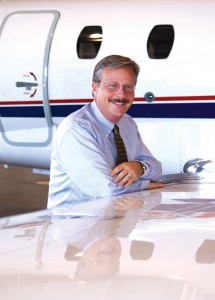
Jack Pelton, chair, president and CEO of Cessna Aircraft Company, and chair of the General Aviation Manufacturers Association, says a user-fee system is illogical.
All three GA trade groups realize that the ATA has grown into a savvy organization. GA trade groups say if the user-fee debate isn’t brought before the public, the ATA could use the political process to get what they want. They pointed out that even while GA was banned from Reagan National Airport in Washington, D.C., air traffic costs didn’t drop much. The GA groups said the majority of costs that support our nation’s ATC system are the airlines’ flight patterns, schedules and hub-in-spoke design. They say that GA business flights aren’t adding a great deal of cost to the system; the nation’s underutilized GA airports support most GA business flights.
“There are more than 4,000 ‘paved’ GA airports overall, and that number is growing; the commercial carriers serve about 500 airports in the U.S.,” says Coyne.
The FAA charges that small jets—which the agency predicts will fill the skies at “alarming rates” as manufacturers produce smaller, cheaper airplanes—will drive up the cost of the air traffic system. They fear VLJs will blacken the skies—soon. May made similar comments and argues, “The system, what we have today, simply isn’t going to work in the future.”
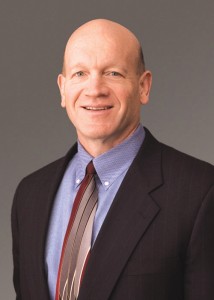
Referring to the Bush administration’s FY2007 budget, James Schuster, Raytheon Aircraft chair and CEO, says if the certification of new aviation products becomes onerous or subject to delays in the U.S., the GA industry will be severely disadvantaged.
In January, James Schuster, Raytheon Aircraft chairman and CEO and past chair of GAMA,predicted, “The toughest battle yet will be to fight against user fees.” He was right. He said he chose both GAMA’s current chair, Jack Pelton (Cessna Aircraft Company’s chair, president and CEO), and GAMA’s president and CEO, Pete Bunce, knowing “they would fight for industry’s stakeholders.”
As the NBAA is fighting a user-fee proposal through its grass-roots organizations, GAMA and Wichita aircraft manufacturer chiefs are going about it a different way. On March 22, Bunce, Pelton and Schuster put a little pressure on politicians to forego any idea of user fees, when they arranged a little congressional get together. Todd Tiahrt (R-Kan.), John Mica (R-Fla.), Vern Ehlers (R-Mich.) and Jerry Moran (R-Kan.)—the Aviation Subcommittee of the U.S. House—flew to Wichita (on a private jet) for a “special aviation” hearing held at the State University’s National Institute for Aviation Research. The hearing’s focus was on “economic competitiveness in the aviation industry.”
Bunce was compelling in his arguments that committee members should support GA with tax relief; he clarified export rules, too. Bunce was clear on another thing: he told the congressional panel that VLJs emerging into the airspace system won’t “clog up the airways.” He said VLJs would stay away from crowded airline hubs; they use underutilized GA airports, which create a robust financial outlook for each of those communities.
The committee heard from Pelton and Schuster. Both men said the GA industry is healthy and growing and plays an important role in our nation’s economy.
“Regulatory changes that put an undue financial burden on GA, inconsistencies in rule interpretations, and illogical regulatory priorities will eventually cripple our industry,” Pelton told the panel.
He also expressed concern with delays in FAA aircraft certification. Pelton said FAA aircraft certification delays are a great concern for Cessna. Schuster echoed those comments for his company, Raytheon, but added that it was crucial to ensure that FAA funding, and its resources, continue to be allocated in the way that Congress intended.
“If the certification of new aviation products becomes onerous or subject to delays in the U.S., the GA industry will be severely disadvantaged in the global marketplace,” Schuster said. He said if that happened, it would result in the loss of our technical leadership, international competitiveness and jobs.
Bunce said commercial airlines are engaged in an “unconscionable strategy,” and the airlines “are trying to shed legitimate costs that are theirs.”
Coyne points out that the proposed budget would have a disproportionate effect on GA businesses.
“Many of the cuts, including a complete elimination of the Small Community Air Service Program, will stifle air service to rural America, where air transportation is the most efficient means of travel,” he continued. “The FAA must look to improving the nation’s aviation infrastructure at all facilities, to include small communities where GA plays a critical role.”
Coyne said NATA was disappointed that the president’s budget has wrongly shortchanged America’s air transportation system. He added that curbing aviation spending, as more people than ever are turning to the skies, doesn’t make sense. He also said because the ATF balance continues to grow with more revenue from GA fuel taxes, to eliminate the trust fund doesn’t make sense either.
“Eliminating the way GA pays into the trust fund and going to a user-fee system would slow national economic growth, particularly in rural America,” he said. “To increase economic activity and further improve the quality of life in our nation, it’s imperative that Congress fully fund the FAA’s facilities, equipment and R&D budgets, so the FAA can plan for the future of American air transportation. There are sufficient funds from the ATF to accomplish this goal.
The bottom line
Many in the GA industry agree that the ATA wants a user-fee system, as their industry has declined, but the GA business industry has grown and continues to do so. Are GA business operations a threat to the airlines? Yes. As the airlines have continued to use its hub-and-spoke system, limiting passengers’ choices, GA business has increased its on-demand flight choices. As the airlines continue to reduce routes and delays continue, GA is doing the opposite—getting people where they “want” to go and getting them there quickly, without delays.
So, is this user-fee battle about jealousy, control and competition? The GA industry concluded a long time ago that was the case. The talk of user fees has been the buzz for a couple of years now—and it escalated when people realized VLJs were for real.
Many interviewed have said GA offers freedom of flight, flexible flight patterns, convenience, security and advanced technologies. It’s only the beginning. It appears that the straw that broke the ATA’s back was the VLJs—vehicles that will further boost GA in virtually every market niche, but threaten the airlines’ revenues.
In trying to justify user fees, the FAA has made disparaging comments about VLJs, such as “The onslaught of VLJs will burden the ATC system.” According to Bunce, such terminology about VLJs is “political posturing.”
The ATA also portrays VLJs as evil vehicles. The agency claims because hundreds of VLJs will enter the market by year-end, large airliners will get stuck in taxi position behind VLJs, causing a taxi-gridlock in the U.S. According to May, that’s another reason GA business aircraft should pay user fees, as GA aircraft, particularly VLJs, will add a significant burden on ATC services. May said it’s not fair that airliners carrying hundreds of passengers would have to wait behind VLJs that carry only four to six passengers.
The GA industry sees these fallacious comments made by the ATA and the FAA as a way to use VLJs as scapegoats to try and change the air traffic system.
GA groups see this whole user-fee idea as a way out for airlines that have made poor business decisions but have no plans to change the way they operate. The FAA hasn’t learned how to manage and control spending, so both the FAA and the ATA want to impose user fees for different reasons.
The call to oppose user fees by the NBAA, NATA, GAMA, AOPA, EAA and the NATCA are reaching hundreds of thousands of people. People aren’t that naive: user fees will be passed on to passengers; they don’t want to pay for them. GA groups pointed out that lat year “passengers” who paid for the 7.5-percent passenger ticket tax paid nearly $7.1 billion of the $10.4 billion paid into the ATF. The groups say the airlines pay less in aviation fuel taxes than all of GA, including piston, turbine or turboprop planes.

Phil Boyer, president and CEO, Aircraft Owners and Pilots Association, says the airlines’ proposal for funding the FAA is nothing more than an attempt to grab control of the air traffic control system and shift costs to other users.
The bottom line, according to Phil Boyer, AOPA president: “The airlines’ proposal for funding the FAA is nothing more than an attempt to grab control of the air traffic control system and shift costs to other users. If the airlines can control the ATC system and how much it costs to use it, they can also control general and business aviation’s access to it.”
Coyne said NATA, as well as other GA groups, agree with the ATA that modernization of the air transportation system needs to happen, but fuel taxes paid by GA that contribute to the airspace system from the general fund should remain as is.
“Aviation fuel taxes have been in place since 1970; they continue to remain the best way to raise revenues for the ATF,” he said. “User fees would require the federal government to establish a separate cost-accounting system, which would result in even more bureaucracy, as collectors and auditors would be necessary to ensure the integrity of the system.
“Additionally, each aviation operator, including both the airlines and GA, would have to bear increased costs in the form of staff to assess each bill and make sure the charges are accurate. Such a protection against a user-fee plan was only for piston aircraft air travel for the flying public. Everyone in the industry knows that the airlines are the cost driver for the national air transportation system.”
Bolen said that airline advocates have argued that a ‘blip is a blip,” and it costs no more for ATC to handle a 737 than a Cirrus or a Citation. But Bolen pointed out, “a blip at 7:00 a.m. at O’Hare isn’t the same as a blip at 10:00 a.m. at a smaller field. It’s the airlines that drive up system costs.”
The GA industry has another concern about user fees: safety. Bunce said some countries that have embraced user fees have had documented cases of pilots being killed, because they tried to avoid user fees by flying under visual flight rules.
As for the FAA asking for more money, citing a crisis, Coyne says that transformation of the funding system shouldn’t occur until after the government overhauls the ATC. He says the government should make ATC more competitive instead of running it as a monopoly. He questions if there’s a funding crisis.
“The crisis existing isn’t one of a need for money; it’s the need to get the FAA costs under control,” he said.
Coyne said the ATA’s claim that business aviation doesn’t pay its fair share, and that it should pay a larger portion of the FAA’s costs, is going to meet with a lot of resistance from Congress. He pointed out that after Canada adopted a user-fee system, it ended up with GA paying both a user fee and fuel taxes, so he warns it could happen in the U.S.
The GA industry points out that if airlines are providing nearly 85 percent of passenger miles, which they don’t like talking about during this user-fee debate, then paying about 82 percent of the costs isn’t so unreasonable. GA industry groups all agree that the air traffic system was designed to meet the needs of the airlines, not GA. As such, the groups believe it’s fair they should pay for their system the way they have been, and that the airlines should stop looking for government bailouts.
“The bottom line—guess we’ll have to wait and see what happens next. The fight has just begun,” said Byer.











